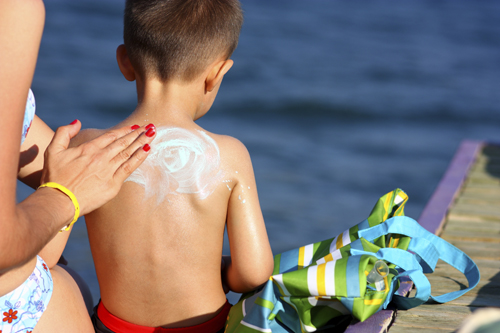25 Aug Protect your Skin from the Sun with a simple Nudge!
by Diana Marino and NFK Team
As a Mom, I feel it is critical to impress upon our kids to take care of their skin at a young age. My son knows when we go to the park, pool, or any activity in the sun that is it just part of our routine to apply sunscreen. It is great to have fun in the sun but it’s important to keep a few things in mind.
Diana Marino, a parent of two children and a Health Coach and Senior Manager of Beautycorner shares:
Here are my top 10 tips for protecting your kids and yourself from the sun:
- Minimize sun exposure
- Wear Sunscreen daily
- Liberally apply sunscreen
- Wear Sunglasses
- Get vitamin D
- Set a good example (as a parent)
- Do not use sunscreen as a tool to prolong your time in the sun
- Examine your skin regularly
- See a dermatologist annually for a full body skin check
- Avoid Tanning Salons and self tanning creams
The Nudge by NFK Team: After arriving on the beach or another sunny place in the Summer, explain to your kids the following ‘Game’. When your phone rings in a specific sound-alarm (you choose the time, kids can choose the sound), everyone should gather under a sunshade place (usually an umbrella). Then, the whole family applies sunscreen on themselves and after that they are allowed to consume their favorite snack or drink.
All you need is a mobile phone or just an alarm. So easy, so effective!
More from Diana Marino explaining in details about her 10 tips.
- Minimize your sun exposure
Between the hours of 10am-2pm, when the sun is the strongest, and be sure to wear hats, shirts, and protective clothing whenever you can. Keep in mind that dark colored clothing will protect better than a white shirt. - Wear Sunscreen daily
It’s a good idea to have a sunscreen built right into your daily face moisturizer. Be sure to apply to those often forgotten about areas like the ears, head, nose, back of neck. These are the areas when the majority of basal cells are found. Be sure your sunscreen offers Broad Spectrum coverage and is SPF 30 or above. Use a sunscreen that is mineral based and that does NOT contain Oxybenzone, an endocrine disrupter. In an ultra violet light sunscreen will make your skin appear black, thus protecting it from the sun. - Liberally apply sunscreen
Apply to skin 15 minutes before sun exposure, 80 minutes after swimming or sweating, or immediately after towel drying. And Reapply as necessary, at least every 2 hours when in the sun. Remember that reapplication is the key with any safer mineral formulas. Unlike chemical blockers, the sunscreen offers physical protection from the sun and should be applied often - Wear Sunglasses
Not only do they look fabulous you are protecting your eyes as well as the delicate skin around your eye. In an Ultra Violet light sunglasses will appear black and that is because UV rays do not penetrate through glass. - Get vitamin D
There is speculation but not proof that adequate levels of vitamin D can reduce the risk of melanoma. Most of us who live in the Northeast need to supplement with Vitamin D to prevent deficiency. If you are taking a good quality fish oil daily with Vitamin D you should have adequate levels. The fat in the fish oil with help with the Vitamin D absorption, especially in the months your skin is not exposed to the sun; for example, in the Winter living in the Northeast. - Set a good example
Our kids watch everything we do and they often try to mimic us. If we are applying sunscreen on our skin and taking proper care, our kids are much more likely to follow suit. - Do not use sunscreen as a tool to prolong your time in the sun
We should look for shade whenever possible and wear protective clothing. If we plan to be in direct sun then of course sunscreen is needed but use common sense when it comes to duration of time spent in the sun. Don’t let yourself get sunburn! Especially with children as early life sunburns are worse. - Examine your skin regularly
You know your skin best. Be sure to be proactive and look for moles or spots that that have changed in color, size, or symmetry. Also, if there is a spot that is itchy or bleeding it should be look at by a dermatologist. - See a dermatologist annually for a full body skin check
Your doctor will use a magnifier to look at any suspicious marks. They really know what they are looking for and help you to monitor those hard to see spots like your back. Also, you will probably get a nice pep talk reminding you about the Sun’s dangers which is often a good reminder. - Avoid Tanning Salons and self tanning creams
Tanning beds have been known to increase your chances of Melanoma, the potentially fatal form of skin cancer. Many ingredients used in self tanning creams have not fully been tested for safety.
“As a Certified Health Coach, taking good care of our skin, our body’s largest organ, has always been self-care I encourage to my clients. For the most part, we are all born with good skin. How we take care of our skin is up to us. It is the first thing someone sees when he or she looks at us. When our skin looks radiant it can be a sign of good health and vitality. We all want to look (and feel) our best and taking proper care of our skin is one way to accomplish this. Protecting our skin from the sun is one important aspect of skin care.”




